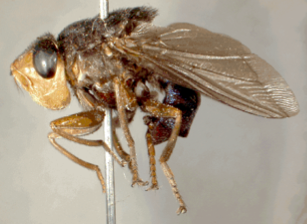Ladies and gentlemen, I introduce to you, the Human Botfly.
Why hello there good sir.
So, so far it's not that bad right? You're probably guessing that it's venomous, or poisonous in some aspect, but in technical terms, they're actually pretty darn harmless. While I don't suggest you going around trying to find one to give a grand old hug, chances are, you can't become physically maimed/disabled by a Botfly.
These insects, highly resemble the shape and size of a bumblebee, hold the obvious color difference. However, how they reproduce now, is another story. Being a parasitic organism, a normal Botfly would target mammals such as horses, sheep, and even cats. A Human Botfly, as in it's name, targets humans for it's source of life.
In the Dermatobia Hominis or Human Botfly's reproduction process, the actual adult botfly's only role is to fly around looking for a mosquito or tick until it's caught one. Afterwards, it simply a manner of laying a few eggs on it, and letting it go on it's merry way. The purpose of using a mosquito or tick is linked to how badly the botfly is at inconspicuously biting you and laying eggs at you.
When the mosquito lands on a human (a.k.a. you), the egg is either transferred from the mosquito into the bite wound directly, or it simply falls off around the wound during the process. (Hey, nature isn't perfect.)
Eventually, the small egg hatches under the warmth of your beautiful body and after hatching, it'll eat/burrow its way "beneath the skin", and begin the long process of feeding and growing. As it feeds on tissue and muscle, tiny hooks keep them where they are and a small hole, the size of a pinhead, allows the Botfly to breath freely and to remove waste fluids.
"ASTGHHHGFHDSZ $^N #QBVT$W!"
The initial wound would have developed into a boil-like bump, which will secrete pus and other fun fluids. Since this is a relatively large parasite in the perspective of a human parasite, most people say that they can feel the parasite squeeze and wiggle around. How fantastic!
After about 42 days or so, it'll fully mature and get this, burrow out of your flesh and out onto the ground to become a flying Botfly like his parents. (And thus repeating the process.)
Lovely, eh?
"I agree, it is lovely"
For the most part, people tend to not like parasites inside of their flesh eating their tissues and wiggling around. The larvae can be removed by squeezing them out, but since the larvae is hooked into the body, parts of the larvae may remain and become infected. Usually, a minor surgery is the best option.
Other people, lure the larvae out by cutting off it's source of oxygen from the hole with smoke or heat. Once the Botfly begins to crawl up to the surface, a person would often grab it out with either hands or tweezers of some sort. Alternatively, you could completely seal up the hole on the skin with duct tape or bandages, which would eventually force the Botfly out of the hole due to lack of oxygen, making it 86% more feasible, to grab it out.
In some extremely rare cases, Botflys have found their way into people's eyes, and brains. The result could be a lost of an eye, or even death. Thankfully for you, it is rare, and commonly caught early. (When your eyelids/eyes are growing bumps as large as pennies and nickels, you usually begin to worry a little.)
If you're starting to wonder how common these botflies are, and how dangerous they might be, allow me to mention that the wounds usually heals, leaving nothing but a few small scars. Along with that fact that they don't commonly live in urban environments and prefer tropical regions, you're safe from the horrors of the botfly. (Unless you go on vacation.)
At the end of the day you come to terms with it, and find yourself strangely attached to it. (Get it? Pun.)
PROTIP: Under any circumstances, don't look up "Botfly removal" on any video website. You have been warned.
Note: Technically, I did you all a favor by not posting pictures of people removing Botflies; I don't think you want to see bloody holes on a guy's leg with crazy white pus-like maggots playing peek-a-boo with a nurse trying to take it out. So you owe me one, don't worry, I'll put it on your tab.










